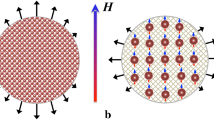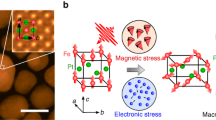Abstract
A theoretical investigation of the effect of mechanical stresses on the remanent magnetization has been performed in terms of the model of single-domain noninteracting nanoparticles. Relationships have been obtained which define two main types of remanence in the entire range of stresses. In the low-field approximation, the magnetization of the first type, whose mechanism of formation is similar to that of the normal remanence, is quadratic in both the magnetic field and stresses and only slightly changes with increasing stresses. Depending on the relationship between the magnetostriction constants, this magnetization can both increase and decrease with increasing stresses. The magnetization of the second type, which arises as a result of a nonmonotonic behavior of the critical fields of nanoparticles depending on mechanical stresses, is proportional to the magnetic field and mechanical stresses. It has been shown that the longitudinal remanence arising in the field of stresses parallel to the magnetic field is always greater than the transverse remanence. The behavior of the remanence with increasing mechanical stresses depends substantially on whether this magnetization is formed in a loaded state or in a state unloaded after plastic deformation. In the range of deformations where the anisotropy of the applied stresses is less than the magnetocrystalline anisotropy, the plastic tension should lead to a decrease in the magnetization as compared to that arising in the plastically undeformed state. Plastic compression can lead to both an increase and a decrease in the remanence.
Similar content being viewed by others
References
S. V. Vonsovskii, Magnetism (Nauka, Moscow, 1971; Wiley, New York, 1974).
E. I. Kondorskii, “Magnetization of Ferromagnets under Stress Depending on the Character of the Magnetic Field Growth,” Dokl. Akad. Nauk SSSR 20, 117–120 (1938).
E. I. Kondorskii, “Hysteresis of Ferromagnets,” Zh. Eksp. Teor. Fiz. 10(4), 420–440 (1940).
M. V. Dekhtyar, “Effect of Elastic Stresses on the Initial Susceptibility of Single Crystals,” Zh. Eksp. Teor. Fiz. 8(11–12), 1124–1134 (1938).
M. V. Dekhtyar, “Magnetic Texture and Magnetelastic Hysteresis,” Zh. Eksp. Teor. Fiz. 9(4), 438–443 (1939).
S. V. Vonsovskii and Ya.S. Shur, Ferromagnetizm (Gostekhizdat, Moscow, 1948) [in Russian].
T. Nagata and H. Kinoshita, “Studies on Piezo-Magnetization (I),” J. Geomagn. Geoelectr. 17(2), 121–135 (1965).
T. Nagata and B. J. Carleton, “Notes on Piezo-Remanent Magnetization of Igneous Rock,” J. Geomagn. Geoelectr. 20(3), 115–127 (1968).
T. Nagata and B. J. Carleton, “Notes on Piezo-Remanent Magnetization of Igneous Rock, III: Theoretical Interpretation of Experimental Results,” J. Geomagn. Geoelectr. 21(3), 623–645 (1969).
T. Nagata, “Basic Magnetic Properties of Rocks under the Effect of Mechanical Stresses,” Tectonophysics 9(2–3), 167–195 (1970).
M. Ohnaka, “Stability of Remanent Magnetization of Rocks under Compression—Its Relation to the Grain Size of Rock-Forming Ferromagnetic Minerals,” J. Geomagn. Geoelectr. 21(2), 495–506 (1969).
V. G. Kuleev, T. P. Tsar’kova, A. P. Nichipuruk, V. I. Voronin, and I.F. Berger, “On the Origin of Essential Differences in the Coercive Force, Remanence, and Initial Permeability of Ferromagnetic Steels in the Loaded and Unloaded States upon Plastic Tension,” Fiz. Met. Metalloved. 103(2), 136–146 (2007) [Phys. Met. Metallogr. 103 (2), 131–141 (2007)].
V. G. Kuleev and T. P. Tsar’kova, “Effect of Plastic Deformations and Heat Treatment on the Behavior of the Coercive Force under Load,” Fiz. Met. Metalloved. 104(5), 479–486 (2007) [Phys. Met. Metallogr. 104 (5), 461–468 (2007)].
V. G. Kuleev, T. P. Tsar’kova, and Zh. V. Kazantseva, “Effect of Plastic Deformations on the Dependence of the Remanence of Steels on Elastic Tensile Stresses,” Fiz. Met. Metalloved. 107(5), 468–471 (2009) [Phys. Met. Metallogr. 107 (5), 435–438 (2009)].
V. G. Kuleev and T. P. Tsar’kova, “Magnetoelastic Effect in Plastically Deformed Ferromagnetic Steels in Weak Magnetic Fields,” Fiz. Met. Metalloved. 108(3), 227–236 (2009) [Phys. Met. Metallogr. 108 (3), 217–225 (2009)].
E. I. Kondorskii, “On the Theory of the Coercive Force of Steels,” Dokl. Akad. Nauk SSSR 63, 507–510 (1948).
D. J. Dunlop, M. Ozima, and H. Kinoshita, “Piezomagnetization of Single-Domain Grains: A Graphical Approach,” J. Geomagn. Geoelectr. 21(2), 513–518 (1969).
L. L. Afremov and V. I. Belokon’, “Effect of Mechanical Stresses on the Magnetic States and the Critical Field of Single-Domain Particles,” Izv. Akad. Nauk SSSR, Fiz. Zemli No. 2, 101–104 (1980).
L. L. Afremov and V. I. Belokon’, “Effect of Mechanical Stresses on the Processes of Formation and Destruction of the Remanence of a System of Single-Domain Particles,” Izv. Akad. Nauk SSSR, Fiz. Zemli No. 8, 101–107 (1980).
L. L. Afremov and A. V. Panov, Remanence of Ultradispersed Magnets (Far East Univ., Vladivostok, 2004) [in Russian].
L. L. Afremov and A. V. Panov, “Effect of Mechanical Stresses on the Saturation Remanence of a System of Nanoparticles,” Fiz. Met. Metalloved. 106(3), 248–256 (2008) [Phys. Met. Metallogr. 106 (3), 238–246 (2008)].
Y. Syono, “Magnetocrystalline Anisotropy and Magnetostriction of Fe3O4-Fe2TiO4 Series with Special Application to Rock Magnetism,” Jpn. J. Geophys. 4((1)), 71–143 (1965).
S. Chikasumi, Physics of Ferromagnetism. Vol. 2. Magnetic Properties and Practical Application (Syuokabo, Tokyo, 1983; Mir, Moscow, 1987).
Author information
Authors and Affiliations
Additional information
Original Russian Text © L.L. Afremov, Yu.V. Kirienko, 2011, published in Fizika Metallov i Metallovedenie, 2011, Vol. 112, No. 1, pp. 15–27.
Rights and permissions
About this article
Cite this article
Afremov, L.L., Kirienko, Y.V. Effect of elastic and plastic deformations on the remanent magnetization of an ensemble of nanoparticles. Phys. Metals Metallogr. 112, 13–24 (2011). https://doi.org/10.1134/S0031918X11040028
Received:
Published:
Issue Date:
DOI: https://doi.org/10.1134/S0031918X11040028




